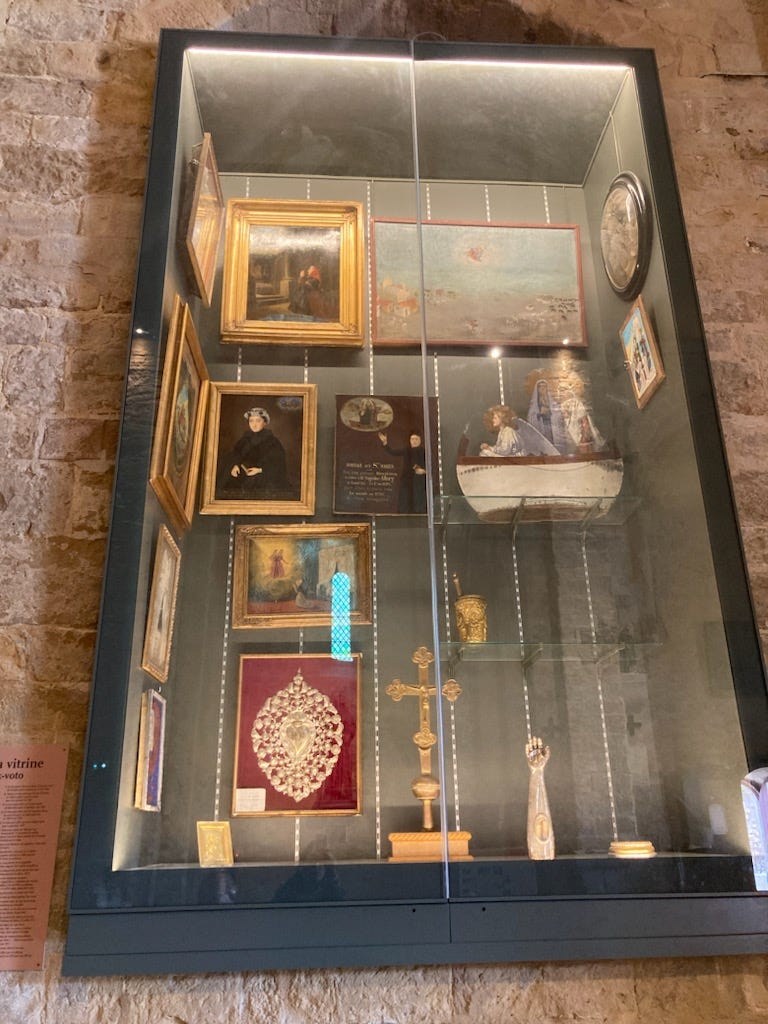A collection of sacred objects studied during a research trip to Saintes-Maries-de-la-Mer this past week
Seven sacred sites
Four cups in a quart
Eight hundred fifty-six known planetary systems
Seven seas
Five thousand two hundred eighty feet in a mile
Seven continents
Seven planets
An estimated 100-200 billion galaxies in the observable universe
Seven energy wheels of the body
Three stages in a rite of passage
One boat in the sea outside my window
Ten fingers attached to two palms whose lines are constantly changing
Twenty seven books brought on a trip lasting six weeks
Three thousand nine hundred and twenty-five miles between home and where I find myself now
Though maybe, in some way, there are no miles between home and where I find myself now
Eighty-four miles stretched between the two locations I root myself in
Thirty-two hours it would take me to walk that distance, a pilgrimage I’ve always wanted to make
Five feet and two inches mark the distance from where I begin above and below
Twenty-two feet coiled up inside of me, the line of Fire, the place where sorrow and joy meet
I have looked up the equations of unanswerable questions, and they are the ones that interest me the most:
How many sites of pilgrimage are there in the world?
How many intersections of ley lines, upon which we can whisper our prayers and trust that they are traveling to the ones we love most?
How many wolves were born today on planet Earth?
How many people can I hold in this one pumping heart?
Where did the dragons go?
How do I let go into all of the change that is moving from and through me?
How many years has it been since humans convinced themselves that they could do without ritual?
Who decided it was a good idea to create entire methodologies upon which we learn to divert ourselves from our bodies?
How big is the sky?
What does the sunset look like through the chromatic retinal circuit of another person’s physiology?
At some point, my questions run out of proverbial steam. I know this as soon as my body starts to ask to find forward motion: a walk, a swim, a hike, a pacing of the room I find myself in. Every morning I make lists to survey the topography of my mind. Numbers, questions, movements, words connected by a shared rhythmic pattern or first letter, sensations; it all rises to the surface, revealing the new landscape that I’m walking into as I roll out of bed in the morning. Or, as was the case at four o’clock this morning, sat straight up in the middle of the night to have a cup of tea with the night sky.
It is a new intimacy, this pattern of behavior: of naming what is, there, right in front of me, and of promising to take my body along with me as my mind surveils the new cartographies that are mapped as I listen closer to the actions that each day is inviting me to participate in.
When I was in college I first came across a book that has since been my closest companion in times of swift change: M Train, by Patti Smith. The book now houses a personal archive of all the places through which it has been a companion: a ticket to a chamber music concert when I was on a research trip at the University of Cambridge, a hospital bracelet from when my mother had cancer, photographs of loved ones, a train ticket to Berlin, a receipt from a deli in Tel Aviv, a matchbook from a hotel in Paris, a phone number written on a napkin at a bar in Amsterdam…and on and on. It makes me think of how many holy objects constantly surround, and how the only thing that separates a sacred object from a “mundane” one is the amount of attention it receives.
What is a reliquary? I am currently enmeshed in a long-term endeavor of archiving the reliquary of the body. In establishing this method of notetaking, scribing, and synthesizing the abstract information of the body, I am studying reliquaries of old: holding spaces that contain objects with a sacred power. What makes a site holy is the phenomenon of attention, is the spear of the mind aiming its power in the direction of a beloved site. There is increasing archaeological and anthropological evidence that many sacred sites occur at critical junctures along the Earth’s tectonic plates. How extraordinary, then, that the instinct of human attention has driven us directly into communion with the reliquary of Earth.
It is of interest to me to place this idea in conversation with the body, our singular reliquary. What sacred objects are stored inside of us? How might our attention be sharpened, paid tribute, redirected? How can we remember to honor that which is sacred within us? How do we allow the space to commune with and identify that which is stored inside of the holding space of our bodies? In many ways, I have devoted my life thus far to the study of memory: to the marking of time through the body and through relationship with the living world. I ask these questions to expand that endeavor: how might our recognition of time and our filing of memory also contribute to the sharpening value of our present moment experiences within the sensations of the body?
I’ll leave you with that, for now, and welcome you to write me if it strikes you.
Xx



